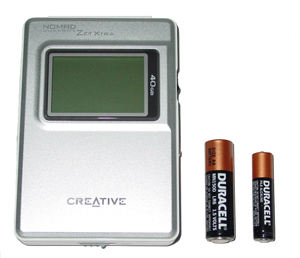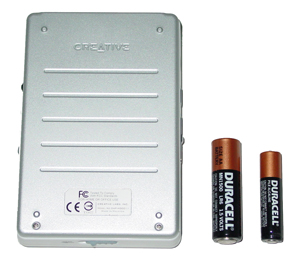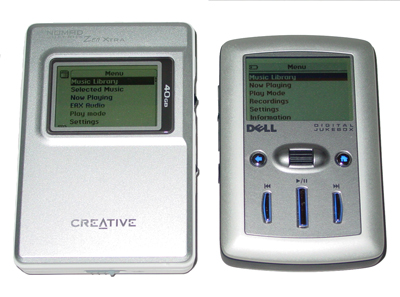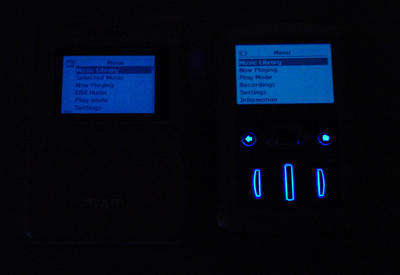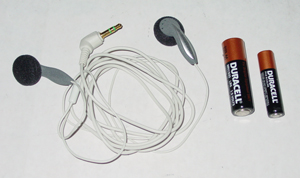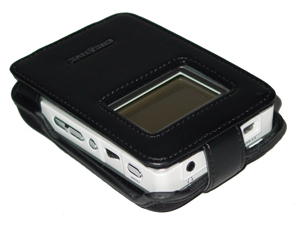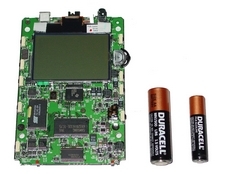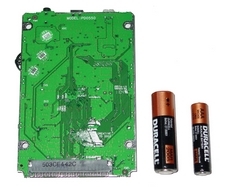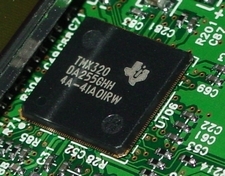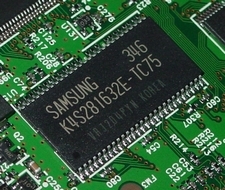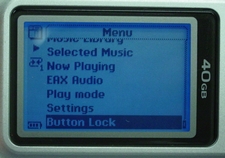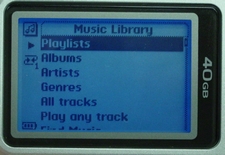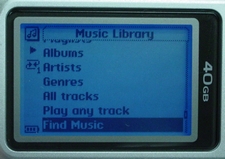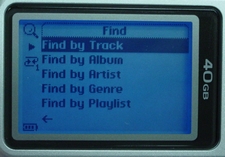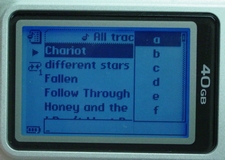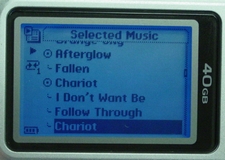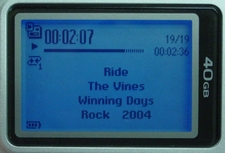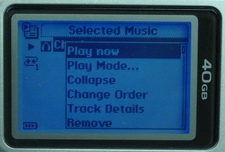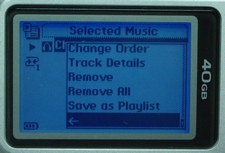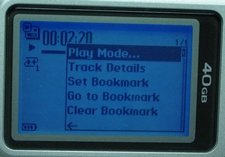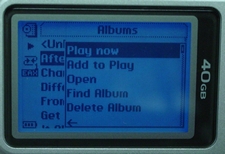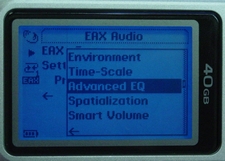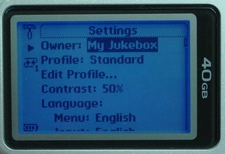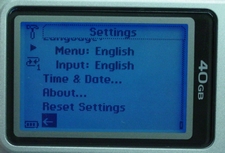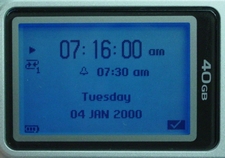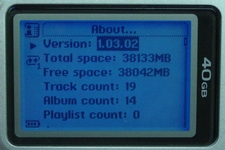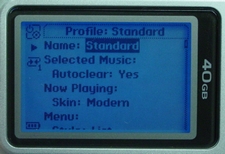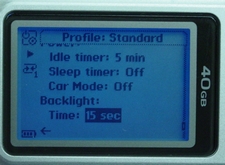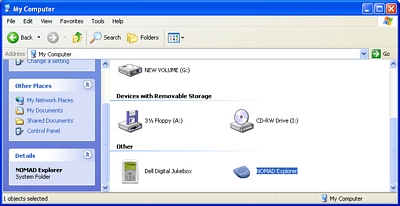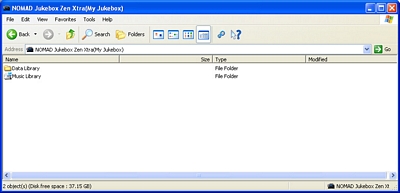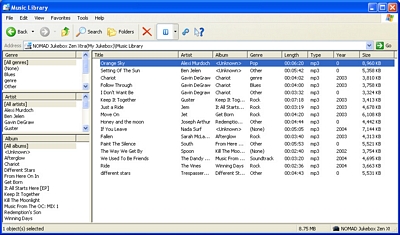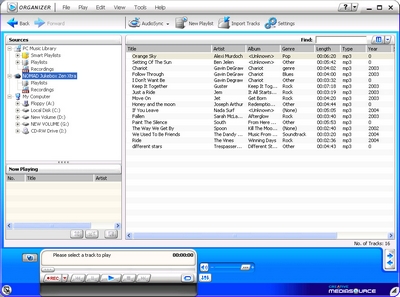
Original Link: https://www.anandtech.com/show/1373
Creative Labs' Nomad Jukebox Zen Xtra 40GB - Extra Storage
by Andrew Ku on July 3, 2004 12:10 AM EST- Posted in
- Smartphones
- Mobile
We are slowly chipping away at the available MP3 players on the market, and this time we have Creative Labs' Nomad Jukebox Zen Xtra 40GB in house. The Dell Digital Jukebox, which we would recommend as an alternative to Apple's iPod for those on a budget, is manufactured by Creative and is based on the Jukebox Zen NX/Xtra platform. While Creative was chosen by Dell, they still manufacture and sell plenty of MP3 players under their own name.
Starting with the Jukebox Zen, Creative started to shift their focus from a CD player styled MP3 player to one that is more in style with the likes of the iPod: sleek, rectangular, hard drive based, etc. (format switch from the Jukebox/2/3 to the Zen series). The problem with the Jukebox Zen was that it was still large, bulky, and quite frankly, not exactly something easy to tag along with you on a flight. The Jukebox Zen NX was something more in line with what could be competitive with Apple's iPod in terms of dimensions alone.
Built on the Jukebox Zen NX platform, the Jukebox Zen Xtra is almost identical, but it ups the ante with a bigger/better LCD screen and higher capacity hard drive. While the Jukebox Zen NX comes in 20GB and 30GB models, the Jukebox Zen Xtra comes in 30GB, 40GB, and 60GB capacities.
Nomad Jukebox Zen Xtra 40GB - Family Flagship
Technically, the Jukebox Zen Xtra can be considered the current Jukebox's family flagship. The Jukebox Zen Touch is the newest of the Jukebox family, but it is mainly targeted as Creative's newest answer to Apple's iPod (we will get to this MP3 player sometime later). Aside from the Jukebox Zen, the Jukebox Zen Xtra is the only hard drive based MP3 player from Creative to hit the 60GB marker.Measuring at 4.4 x 3 x 0.86 inches, it is slightly larger and heavier than the Dell Digital Jukebox (4.1 x 2.7 x 0.86 inches, 7.61 ounces). Its dimensions actually make it about the same size as the Dell Axim X5 (5.04 x 3.21 x 0.71 inches, 6.91 ounces), though the Jukebox Zen Xtra is slightly shorter, slimmer, and thicker.
The Jukebox Zen Xtra (all versions) weighs 7.2 ounces (7.9 ounces with the battery pack installed). Its weight and size make it quasi-bulky in our opinion, as the Dell DJ seemed to be the perfect fit for the Jukebox platform.
On the front side, only the LCD screen is visible, while the back side is completely bare. The removable battery pack is inserted beneath the front bezel, which acts as a cover that can be released by the security tab on the bottom side of the MP3 player.
The size difference of the Jukebox Zen Xtra becomes apparent when you place it next to Dell's Digital Jukebox. Both are based on the same hardware platform, but Creative's choice to design theirs around a removable battery means that their unit needed to be slightly larger.
The Jukebox Zen Xtra only uses a backlight on their LCD screen, as the buttons for this MP3 player are completely solid and opaque. The only issue that we have with the backlight is that it is slightly, but noticeably, dimmer. After getting accustomed to the Dell Digital Jukebox and other MP3 players, we found the Jukebox Zen Xtra to be a bit dimmer than we liked. Dell got the brightness of their LCD screen on the Digital Jukebox just right.
Nomad Jukebox Zen Xtra 40GB - Family Flagship (cont.)
All of the access ports for the Dell Digital Jukebox MP3 player are aligned on the top side and include (left to right): headphone port, power port, and USB port (2.0/1.1).Unlike the Dell Digital Jukebox, the Jukebox Zen Xtra has all of its navigational and function buttons on the right and left sides of the unit. On the right side, Creative chose to situate the reverse/skip, forward/skip, play/pause, scroll toggle (pressing in is the enter command), and menu button (which is the home button). The reverse/skip and forward/skip buttons look like a single button, but it is actually two different buttons with a single button cover and a slight bridge to separate the two.
The two buttons can be pressed down at the same time, which makes the design a bit odd. If the reverse/skip and forward/skip buttons are going to be placed in this manner, we prefer the way that Dell had designed the volume buttons on the Digital Jukebox, with the buttons being independent of one another.
The bottom side of the Jukebox Zen Xtra is only home to the security switch that holds the cover in place. Removing the cover is the only way to access the removable battery for the Jukebox Zen Xtra.
The left side of the unit is where Creative placed the rest of the buttons (left to right): power, back, and volume up/down. The volume up and down button is designed the same way as the reverse/skip and forward/skip buttons are on the right side of the Jukebox Zen Xtra. We would hope for the future that Creative would make each button in each pair separate from one another.
Nomad Jukebox Zen Xtra 40GB - Family Flagship (cont.)
When the security tab is released, the bottom part of the top cover (anodized aluminum) pops up a centimeter or so, and then the cover needs to be slid down and out to be unhinged from the rest of the unit. The security tab is actually a spring mechanism that is attached to two hooks that is secured to two slots in the cover.The 3.6V Lithium Ion battery pack that the Jukebox Zen Xtra uses is the same used for the Muvo2 and Jukebox Zen NX. We were glad to see that the battery was of the Lithium Ion variety, mainly because of the benefits of constant recharging.
We really enjoy the concept of a removable rechargeable battery because this brings back the ability of swapping batteries to increase battery life. No longer is there a need to stop and wait for a recharge before use; if you have a spare battery, swapping in and out makes recharging a second thought.
The only issue we have is that charging can only be done within the unit. You can't just swap a battery out and charge it while using another. Creative hasn't made a recharging bay/station available that charges their removable battery, which is something that would be great for the future. The only way that you can swap batteries in and out for a long flight is to charge each battery one by one before you go, and recharge them one by one afterwards.
The headphones included for the Jukebox Zen Xtra are the same ones that are included with the package for the Muvo2 4GB MP3 player. The odd thing about this pair of headphones is that they are overly large. The earbuds themselves don't quite fit (several people have commented on this), and they are even more uncomfortable due to the increased size that the padding adds to them. To be perfectly honest, we can't imagine most people using these headphones without some sort of a complaint.
Comparing an earbud on this headphone set to our new Apple in-ears helps show the relative size difference. The earbud size for the Apple in-ears is actually the medium sized one, which just goes to show how large the headphones are that come bundled with the Jukebox Zen Xtra and Muvo2 4GB.
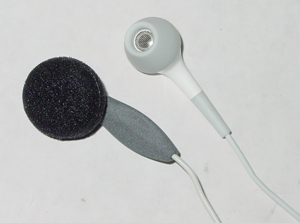
Aside from the headphones, battery pack, and power adapter, Creative also includes a holster with a belt clip to hold the Jukebox Zen Xtra. Overall, the design of the holster is well done, the LCD screen is visible, all of the buttons are accessible and so are the USB and headphone ports. This means that the only time you need to remove the MP3 player from the holster is when you want to charge the unit, since the security clip blocks the power port.
While it is nice in design, it doesn't work well when put to use. The Jukebox Zen Xtra is already quasi-bulky, and the addition of the holster only makes the MP3 player cumbersome. We preferred to use it without the holster when we went out.
Nomad Jukebox Zen Xtra 40GB - Under the Hood
The circuit board for the Jukebox Zen Xtra is fairly simple, and we suspect that the circuit board for the Jukebox Zen is basically the same, except for a smaller LCD module. The LCD module (30 x 52mm, 160 x 104 res.), though larger than the one on the Jukebox Zen, is still smaller than the one we saw on the Dell DJ.The front side is home to a Texas Instruments TMX320 digital signal processor that seems to be related to the TMS320VC5509A series, NEC uPD720122 USB 2.0 controller, Samsung K4S281632E-TC75 TSOP 8MB SDRAM, and Silicon Storage Technologies' SST39VF400A 4MB Flash chip.
The NEC USB 2.0 controller is actually hidden below the left side of the LCD module, which is soldered down and prevents us from getting a clear snapshot.
Unlike some of the other hard drive based MP3 players, the Jukebox Zen Xtra uses a 2.5 inch slim hard drive, which is typically seen use in ultraportable and thin and light laptops. The 40GB model of the Jukebox Zen Xtra uses the Fujutsu MHT2040AT 4200RPM 2MB hard drive, and we suspect that the 30GB and 60GB models use the related hard drives from the Fujitsu MHT20X0AT family.
Nomad Jukebox Zen Xtra 40GB - Interface
Creative has a standard OS for all of their Jukebox Zen products. Dell's Digital Jukebox utilizes the same base OS ported over with a slightly tweaked GUI and appearance. The latest firmware revision for the Jukebox Zen Xtra is 1.03.02, which is what we have been using in our review.The left side of the screen is where Creative situated the play/pause/forward/reverse/skip, play mode, and EAX icons.
The music library is basically the same as the one that we saw in the Dell DJ, but the Find Music option is a separate option that is not under the albums, artists, genres, or all tracks submenus.
Going into the Find submenu provides more options, and each Find By option is basically the same with an interface for finding a particular entry. Each Find By option has an alphabet from which to choose and it then goes to the corresponding entry. It cannot use partial phrases to search, meaning "Follow Through" cannot be found by entering "Through".
Nomad Jukebox Zen Xtra 40GB - Interface (cont.)
The Selected Music and Now Playing are also a bit different than the ported OS that we saw with the Dell DJ. The only major difference is that the Selected Music screen has the tracks sorted by artist, album, or genre. It depends on how the tracks were added to the selected music list in the first place. Using the "play any track" option puts the Jukebox Zen Xtra into shuffle mode, plays all the tracks, and sorts them by album.The Now Playing screen is only different with the addition of the year of the audio track and a display of the total time of the track, instead of remaining time.
The scroll toggle acts as an enter command when pressed in. Hitting enter once brings up the available options for any given entry, and twice actually selects that option.
The Now Playing screen has the ability to set a bookmark, which will mark a particular point in a particular audio track. The rule is one track, one bookmark. Setting a new bookmark after one already is stored for that particular track will override the previous one.
The options available for an individual entry in the music library are basically the same throughout. The only difference is that the Find and Delete options are specific for the screen that you are in, while the All Tracks submenu has a few more options.
Nomad Jukebox Zen Xtra 40GB - Interface (cont.)
Something more specific to the Jukebox line alone are the EAX audio features:- Environment: manipulates the sound to emulate the audio quality heard in a particular environment (auditorium, bath room, cathedral, concert hall, garage, indoor arena, jazz club, living room, opera house, small room, and theater)
- Time-Scale: provides an option to decrease or increase permanently the speed of your music (0.50x, 0.75x, 1.00x, 1.25x, and 1.50x)
- Advanced EQ: equalizer settings with a customizable 4-band setting (custom, acoustic, classical, disco, jazz, new age, pop, rock, and vocal)
- Spatialization: a soundstage effect to specify the band of the audio heard (full, narrow, and wide)
- Smart Volume: provides an option to maintain the volume permanently for all music heard (train, plane, car, late night, and match volume), but it still requires you to change the volume setting to your liking
The Settings submenu is different in the sense that there are set profiles to accommodate different preset and user set settings (standard, advanced, at home, car player, user 1, and user 2). Otherwise, the options are the same (i.e. contrast still ranges from 0 to 100 in 10 unit increments).
Time is also provided as an option, but it is user specified instead of being sync'ed with the host computer.
We did like the profile feature of the Jukebox Zen Xtra, since it allowed us to switch between different sets of settings fairly quickly without losing the previous ones.
Nomad Jukebox Zen Xtra 40GB - Windows Support
Creative's Nomad Explorer is similar to what Dell calls the Dell File Manager. Integrated with Windows' Explorer, it allows easy navigation to the Nomad device and provides an easy way to drag and drop audio tracks to and from the Nomad device.It is also possible to organize the music library on the Jukebox Zen Xtra with Creative's Mediasource Organizer, which we have used in the past with the Muvo2 4GB and MuvoTX. In theory, it would be possible to export recordings from the Jukebox Zen Xtra, but we should note that this particular MP3 player has no ability to record from any audio source.
The Test
Our test bed was simply used to transfer files, nothing more and nothing less. Using lesser scaled system should yield similar results, so long as the system is capable of USB 2.0/1.1.| Windows XP Professional Test System | |
| CPU(s): | Pentium 4 3.0C GHz |
| Motherboard(s): | MSI 875P Neo-FIS2R |
| Memory: | 2GB Kingston HyperX PC4000 |
| Hard Drive: | Seagate Barracuda 7200.7 120GB |
| CDROM: | Pioneer DVD(16X)/CD-ROM(40X) |
| Video Card(s): | ATI All-in-Wonder 9600 XT |
| Ethernet: | Onboard 3Com 10/100 |
| Operating System: | Windows XP Professional SP1 |
| Video Drivers: | ATI Catalyst 3.8 |
Battery charging specs of Creative's Jukebox Zen Xtra (no USB charging capability):
- DC power: full charge in 4 hours
We should note that we encountered an interesting problem when we were testing our Nomad Jukebox Zen Xtra and Dell Digital Jukebox. By coincidence, we used our multimedia test bed to benchmark our MP3 players, which consists of an Asus P4R800-VM motherboard based on the 9100 IGP chipset. For whatever reason, the USB drivers seemed to have some sort of a conflict with the Jukebox series of Creative's MP3 players, which includes the Dell Digital Jukebox.
The problem occurred when we tried to transfer large amounts of MP3s or data files. For whatever reason, the MP3 players would lock up and crash after about the third file. Deleting large amounts of MP3s or data files weren't an issue, but adding them was. This seems to be the greatest problem of the problems out there, but the reasons behind it are various, according to the Creative's knowledge base web page. And another reason to add to the list may be compatible hardware.
Our MSI 875P Neo-FIS2R based test bed didn't have any issues; neither did our Centrino based laptops. We are not sure if this is a measure of Asus' engineering or ATI's, since we have not yet had the time to test out other 9100 IGP motherboards or check out SiS, VIA, or NVIDIA based systems. Either way, we know for sure that there is something definitely wrong with the P4R800-VM, despite our attempts at updating the BIOS and drivers. When we have more free time on our hands, we will look into it.
File Transfer Performance
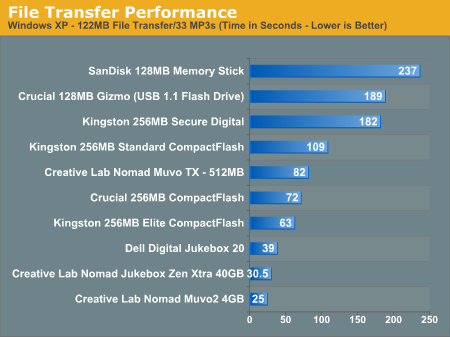
The benchmark numbers that we ended up reporting for the Jukebox Zen Xtra and Dell Digital Jukebox was from our most recent Dell Inspiron 8600 with the ATI MR9600 Pro. The numbers from our MSI 875P Neo-FIS2R test bed were about the same.
Final Words
After taking a look at the Dell Digital Jukebox, we have a bit of a mixed conclusion regarding the Jukebox Zen Xtra. The Dell Digital Jukebox is designed much better in terms of ease of use and portability design. The fact that Creative chose to use small buttons and a scroll toggle (the same size as the one on the Muvo TX) makes accessing the controls a bit cumbersome. The placement/size of the controls and the quasi-bulky dimensions of the Jukebox Zen Xtra are due to the design of the MP3 player that accommodates a removable battery.Our personal preference would be a Dell Digital Jukebox over the Jukebox Zen NX or Xtra. We are willing to forgo the benefit of a removable battery that doesn't have an independent recharging bay for a MP3 player for a better internal and external design. Creative doesn't implement any sort of shock absorption system in their Jukebox Zen NX or Xtra MP3 players, as the hard drives are only secured to the MP3 player frame by four screws. Dell takes an approach that is more in line with a hearty MP3 player that can take a beating, still function, and continue to have a long life.
When you start up the Jukebox Zen Xtra, you can actually feel the hard drive motor spinning, as well as when you transfer files to and from the unit. If you listen close enough, you can also hear the motor and write/read head of the hard drive.
Battery life of the Jukebox Zen Xtra (our 40GB sample) ranked in at roughly 13 hours after about a week and a half of use and tapered off to 12.5 hours soon after, which a little under its spec of 14 hours. Based on our experience with other MP3 players, this is fairly normal in terms of battery degradation. Since the Dell DJ is based on the same hardware platform, we weren't too surprised to receive a similar audio quality, fairly comparable to the iPod.
With Creative pricing the Jukebox Zen Xtra at $239.99, $269.99, $399.99 for the 30GB, 40GB, and 60GB models respectively, they are still selling an MP3 player (GB per dollar) fairly cheap compared to some of the others on the market. Software-wise, Dell's DJ and Creative's Jukebox Zen Xtra both rank at basically the same position with similar solutions. We should note that both are still limited by the inability to import multimedia files (avi, mpeg, wmv, mp3, wav, wma, etc.) directly from the host PC to the player or run files directly off it. The only way to circumvent the issue is to rename multimedia files to data files and then transfer them back to the computer and rename them to run them.
If a high capacity MP3 player is, first and foremost, what you are after, then the Jukebox Zen Xtra is the right one to buy, but keep in mind that you will be trading portability and ease of use. And, for those travelers and on the go, you can't charge this MP3 player via USB.

